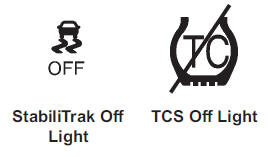StabiliTrak® System
The vehicle has a vehicle stability enhancement system called StabiliTrak. It is an advanced computer controlled system that assists with directional control of the vehicle in difficult driving conditions.
StabiliTrak activates when the computer senses a difference between the intended path, and the direction the vehicle is actually traveling. StabiliTrak selectively applies braking pressure at any one of the vehicle's brakes to help steer the vehicle in the intended direction.
StabiliTrak is on automatically whenever the vehicle is started. To assist with directional control of the vehicle, the system should always be left on.

TCS/StabiliTrak Light
When the stability control system activates,
 flashes on the instrument panel. This
also occurs when traction control is activated. A noise may be heard or vibration
may be felt in the brake pedal. This is normal. Continue to steer the vehicle in
the intended direction. If there is a problem detected with StabiliTrak, the appropriate
message will be displayed on the DIC. See Ride Control System Messages .
flashes on the instrument panel. This
also occurs when traction control is activated. A noise may be heard or vibration
may be felt in the brake pedal. This is normal. Continue to steer the vehicle in
the intended direction. If there is a problem detected with StabiliTrak, the appropriate
message will be displayed on the DIC. See Ride Control System Messages .
When this message is displayed and/or d comes on and stays
on, the vehicle is safe to drive but the system is not operational. Driving should
be adjusted accordingly. If  comes on
and stays on, reset the system:
comes on
and stays on, reset the system:
1. Stop the vehicle.
2. Turn the engine off and wait 15 seconds.
3. Start the engine.
If  still comes on and stays on at
a speed above 20 km/h (13 mi/h), see your dealer for service.
still comes on and stays on at
a speed above 20 km/h (13 mi/h), see your dealer for service.

TCS/StabiliTrak Button
This button is located below the infotainment system screen.

StabiliTrak can be turned off if needed by pressing and holding g until
 and
and
 come on in the instrument panel and
the appropriate message displays on the DIC. When StabiliTrak is turned
off, the system will not assist with directional control of the vehicle or limit
wheel spin. Driving should be adjusted accordingly. Press and release
come on in the instrument panel and
the appropriate message displays on the DIC. When StabiliTrak is turned
off, the system will not assist with directional control of the vehicle or limit
wheel spin. Driving should be adjusted accordingly. Press and release
 again to turn the system
back on.
again to turn the system
back on.
If cruise control is being used when StabiliTrak activates, cruise control will automatically disengage. Press the appropriate cruise control button to reengage when road conditions allow. See Cruise Control for more information.
See also:
Rear Seat Pass-Through Door
The vehicle may have a door in the rear seat that provides access to the trunk.
Lower the rear seat armrest to access the pass-through door. Pull the release handle to open the door.
To close, pus ...
Keys
WARNING
Leaving children in a vehicle with the ignition key is dangerous for many reasons.
Children or others could be badly injured or even killed. They could operate the
power windows or othe ...
Inflation - Tire Pressure
Tires need the correct amount of air pressure to
operate effectively.
Notice: Do not let anyone tell you that
under-inflation or over-inflation is all right. It is
not. If your tires do not hav ...


